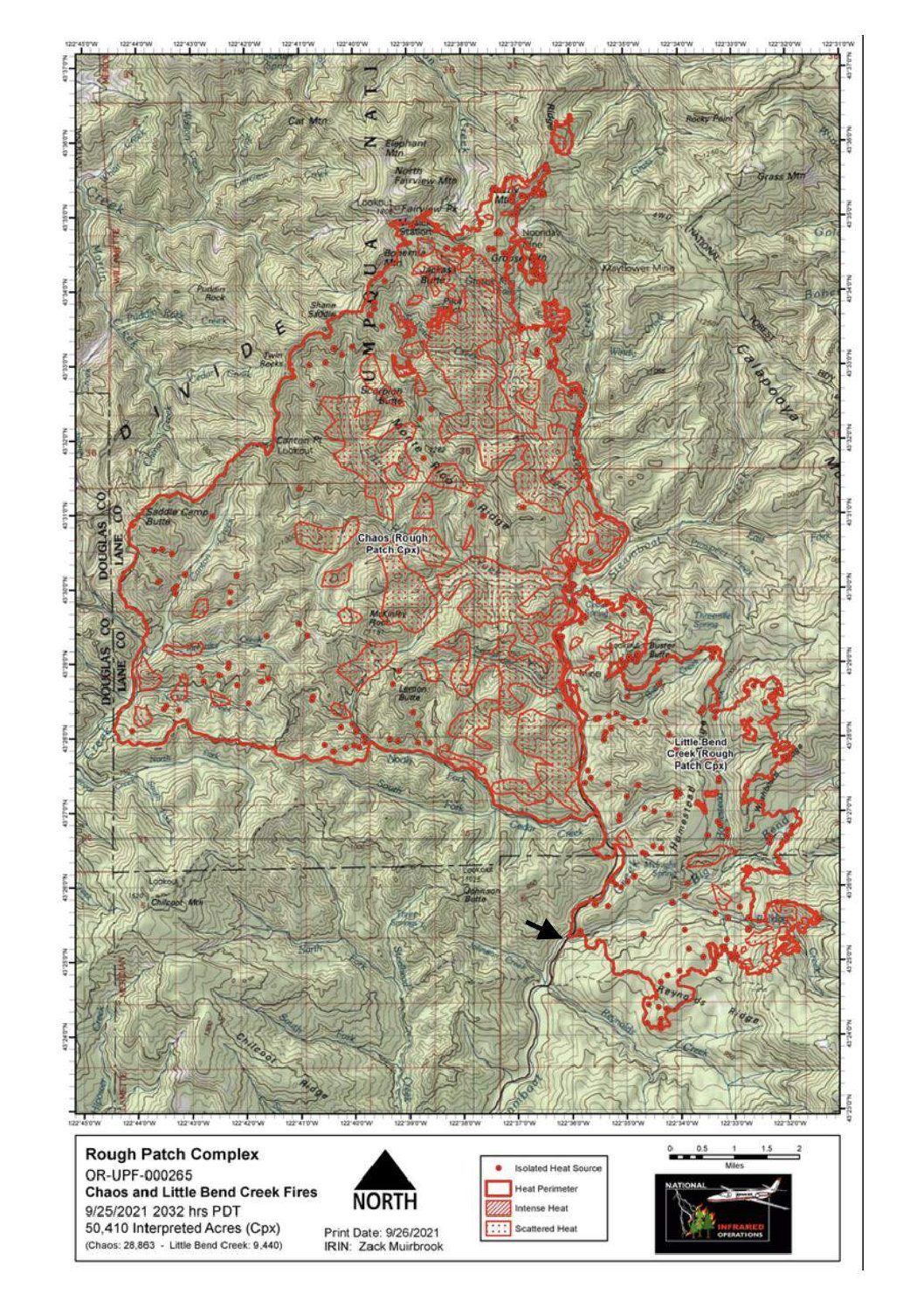FISHWATCH 2021 MONTHLY REPORT
SEPTEMBER 2021
by Edward Kikumoto
Again this year, the U.S. Forest Service and The North Umpqua Foundation (TNUF) is asking the public not to visit the Big Bend Pool (the Pool) due to Covid19 concerns, and to protect the health of the FishWatch Caretaker.
The opinions in this report are strictly my own, and do not reflect the views and opinions of the U.S. Forest Service, the Oregon Department of Fish & Wildlife, or The North Umpqua Foundation.
Greetings from the Big Bend Pool FishWatch 2021 Caretaker,
Big Bend Pool and the Chaos & Little Bend Creek Fires
I have nothing to report on the status of the Big Bend Pool or its steelhead.
I was last at the Pool on July 9, when the Airstream was pulled out of the Basin, four days after the Jack Fire started.
The Steamboat Creek Basin has remained closed to public access since then.
The Chaos and Little Bend Creek fires continue to burn, albeit contained for the most part with the onset of Fall weather and some rain.
Firefighting activity is shifting from suppression to suppression repair activities, and assessments of “the severity of fires effects across the landscape, …plan mitigation measures for exposed soils with increased risk of erosion, and evaluating the area closure surrounding the fires, with the intent to restore public access to more areas as soon as safely possible.” (Jack Fire and Rough Patch Complex Updates)
The proximity of the fires to the Big Bend Pool makes it unlikely that the area around the Pool will be reopened to the public, and allow FishWatch to return to monitoring the Pool anytime soon.
“Unstable roads and slopes, fire-weakened trees, rock fall, and firefighter traffic continue to pose risks to the public.” (Jack Fire & Rough Patch Complex Update, 09.30.21)
“There has been an influx of personnel this week as large equipment, drivers, operators, and contractors are arriving to help with the suppression repair.” (Rough Patch Complex and Jack Fire Daily Fact Sheet Oct. 7, 2021)

Arrow points to the Big Bend Pool.
North Umpqua River Summer Steelhead
Drought conditions over the summer saw historical low flows of the North Umpqua River and Steamboat Creek.
The Oregon Department of Fish and Wildlife (ODFW) also reported in early August that the return of summer steelhead to the North Umpqua River was at a historical low, and estimated 30% of the expected return.
In consequence, the ODFW implemented an emergency closure order for fishing on the North Umpqua River from its confluence to Soda Springs Dam from August 10 to November 30, 2021.
The End of the Fire Season?
Fall is finally coming on and we have had our first two significant amounts of rain this month – a third of an inch mid-month, and a reported two inches at the end of September in the fire areas – enough to stop the fires from growing, but not enough to put them out.
More rain is in the forecast for October, and it is predicted (by some) that the Pacific Northwest will have a colder and wetter fall and winter than normal…we can only hope.
Infrastructure
The Airstream remains on its pad at the Sawtooth House Garage on the USFS/ODOT Steamboat Maintenance Compound.
I have been working on upgrading the Airstream’s internal propane system. The two 30# propane tanks have been recertified for 5-years.
The regulator has been replaced and new hoses installed.
I did this as a contingency in the event the Airstream was to return to the Pool for the end of the season this year, and the impracticality of re- installing the 250-gallon propane tank at the Pool for just this short period of time.
Having a working inline system will also help at the beginning of the season, if there is a delay in having the 250-gallon tank brought up to the Pool by May 15, as happened this year.
BIG BEND POOL FIELDNOTES
Fire in Steamboat Creek Basin
As of September 26, the Chaos Fire and Little Bend Creek Fire totaled 38,279 acres, all of which is within the Steamboat Creek Basin (aka, The Frank and Jeanne Moore Wild Steelhead Special Management Area), which is approximately 100,000 acres.
Most of the prime spawning habitat within the basin is on the western flank of Steamboat Creek, which also includes upper Canton Creek on the western boundary of Steamboat Creek Basin.
“Canton Creek is a major tributary of Steamboat Creek in the North Umpqua River basin…The drainage area is approximately 60 square miles. Canton Creek is a strategically important producer of steelhead trout, coho salmon, chinook salmon and cutthroat trout within the North Umpqua drainage.” (Dr. Dewberry, Pacific Rivers, 2019 Canton Creek Report)
The upper reaches of Canton Creek are also in the Chaos Fire zone. (See the Chaos&LittleBendCreekFiresMap, above.)
The top five spawning tributaries of Steamboat Creek are within the Chaos and Little Bend Creek Fires zones – Little Rock Creek, Horse Heaven Creek, Big Bend Creek (Little Bend Creek Fire), Cedar Creek, and City Creek – in order of productivity. (Table 2: Salmonid counts within reaches of major tributaries Steamboat Creek, Dr. Charley Dewberry, Pacific Rivers, Steamboat Creek Snorkel Surveys 2020)
Almost 60% of the summer steelhead spawning appears to occur in Steamboat Creek itself. (ibid.)
Steamboat Creek and Steamboat Creek Road (FSR 38) between Big Bend Creek and Little Rock Creek run between the Chaos Fire and the Little Bend Creek Fire. (See the Chaos&LittleBendCreekFiresMap, above.)
The lower half of Bulldog Creek, which is the source of Big Bend Creek’s cold spring water, and what makes the Big Bend Pool a thermal sanctuary is within the Little Bend Creek Fire zone.
What does the future hold?
The immediate impact of the fires will be on both the adult and juvenile summer steelhead in Steamboat Creek this summer, and particularly, to the steelhead that are holding in the Big Bend Pool before moving on in the late Fall, as water temperatures fall and rain raises water levels.
Did the fires raise the water temperatures in Steamboat Creek and Big Bend Creek above normal during the summer?
Was the Big Bend Pool too warm for the steelhead holding there?
What effect did the fires have on the juvenile steelhead still in the tributaries in which they were born, which were in the fire zone?
Will this year’s adults be able to successfully spawn in Steamboat Creek and its tributaries within the fire zone?
“Having watched steelhead spawn in Oregon streams for over 30 years, I have observed that steelhead spawning is most successful in years when the highest flow of the year occurs around January 1 and is large enough to move gravel- sized sediment in the spawning areas, and subsequent storms are not large enough to move significant sediment. The spawning strategy of steelhead appears to be that they move upstream as far as possible during the peak storm of the year. They spawn on new gravel that has just moved and been deposited. When steelhead spawn, they are “betting” that each subsequent storm event and peak flow will be lower than the one that they spawned on. If the storm they move upstream on is not large enough to move significant gravel and clear the fines out of it, survival of the eggs is low. If subsequent storms are large and subsequent stream flows are as high, or higher, than the storm they spawned on, the gravel will be moved, which causes the eggs to be scoured out of the gravel.” (Dr. Dewberry, Pacific Rivers, 2019 Canton Creek Report)
What effect will heavy rainfalls have on soil erosion and stream sedimentation to spawning, egg incubation, and survival of juvenile steelhead?
Of particular concern – the Pool, and its summer water temperatures.
Next summer’s concern (and subsequent summers) will be warmer water temperatures in Steamboat Creek and Big Bend Creek from the loss of streamside cover, which protects the water from direct sunlight, and the effect of the Little Bend Creek Fire on Bulldog Creek – too say nothing about soil erosion and sedimentation.
The cold water that makes the Big Bend Pool a thermal sanctuary comes out of Big Bend Creek.
This cold spring water originates from Reynolds Ridge at 43oF (5oC) and flows to Big Bend Creek through Bulldog Creek.
The lower half of Bulldog Creek was in the fire zone.
Much of Big Bend Creek and Homestead Creek, which feeds into Big Bend Creek above Bulldog Creek, were also in the fire zone.
What effect will the fire have on the water temperature of Big Bend Creek in future summers?
How much warmer will Steamboat Creek summer water temperatures get upstream of Big Bend Creek, thus making the Pool even warmer?
We’ll have to wait and see. End of Report
Links:
Rough Patch Complex and Jack Fire Daily Facts, 10.03.21 https://inciweb.nwcg.gov/photos/ORUPF/2021-07-06-0031-Jack-Fire/related_files/pict20210903-114455-0.pdf
Chaos Fire and Little Bend Creek Fire Map 09.26.21 https://inciweb.nwcg.gov/incident/map/7758/4/126553
Canton Creek Snorkel Surveys (2011-2019), Dr. Dewberry, Pacific Rivers https://www.pacificrivers.org/uploads/1/1/9/9/119981094/2019_canton_creek_report_final.pdf
2019 Steamboat Creek Snorkel Survey, Dr. Dewberry, Pacific Rivers https://www.pacificrivers.org/uploads/1/1/9/9/119981094/steamboat_creek_2019.pdf
Steamboat Creek Snorkel Surveys (2020), Dr. Dewberry, Pacific Rivers. Not uploaded to Pacific Rivers yet.

